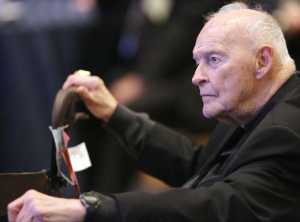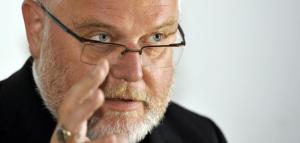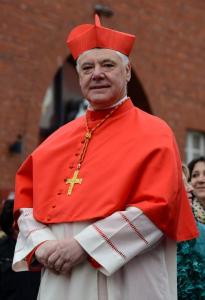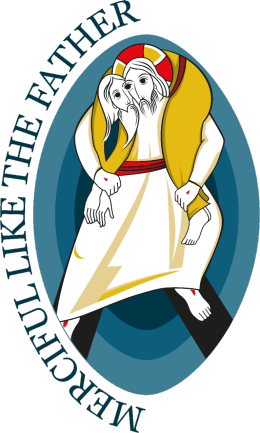Another year nears its end, the seventh of this blog, which is always a good opportunity to look back, especially at what has appeared here in the blog over the course of 2016. I have grouped things loosely in various categories, so as to give an impression of cohesion.
 Pope Francis at work
Pope Francis at work
In Rome, and despite turning 80 this year, Pope Francis kept up the pace, introducing several changes, expected and unexpected. First, in January, he issued a decree which opened the rite of foot washing on Maundy Thursday also for women. I reflected on it here.
On Ash Wednesday, the Holy Father sent out 1,000 missionaries of mercy, among them 13 Dutch priests, as part of the ongoing Holy Year of Mercy.
Pope Francis commented on the question of female deacons, which led to much debate, at least in Catholic social media. I also shared my thoughts.
A smaller debate revolved around an instruction from the Congregation for the Doctrine of the Faith, approved by the Pope, about Christian burial.
The reform of the Curia also continued, first with the creation of the Dicastery for the Laity, the Family and Life and the appoinment of Dallas Bishop Kevin Farrell as its first prefect; and then with the creation of the Dicastery for the Promotion of Integral Human Development, for which the Pope picked Cardinal Peter Turkson as head.
 Pope Francis also added to the College of Cardinals, as he called his third consistory, choosing seventeen new cardinals from all over the world.
Pope Francis also added to the College of Cardinals, as he called his third consistory, choosing seventeen new cardinals from all over the world.
Towards the end of the year, and following the end of the Holy Year of Mercy, Pope Francis issued an Apostolic Letter about the absolution from the sin of abortion, a faculty now extended to all priests.
The Pope abroad
Pope Francis made several visits abroad this year. To Cuba and Mexico, to Greece, to Armenia, to Poland, to Georgia and Azerbaijan, but the last one received the most attention here. For two days, Pope Francis put ecumenism in the spotlight during his visit to Sweden. Announced in January as a one-day visit, a second day was added in June. In October, the Nordic bishops previewed the visit in a pastoral letter, which I published in English.
The abuse crisis
Still here, and unlikely to go completely away in the next years or decades, the abuse crisis continues to haunt the Church. in February there were shocked reactions to comments made by a prelate during a conference on how bishops should handle abuse allegations. I tried to add some context here. In the Netherlands there was indignation when it became clear that a significant number of abuse cases settled out of court included a secrecy clause, preventing victims from speaking negatively about the Church institutions under whose care they suffered abuse. In April, the annual statistics of abuse cases processed and compensation paid out were released.
Amoris laetitia
In April Amoris laetitia was released, the Post-Synodal Exhortation that was the fruit of the two Synod of Bishops assemblies on the family. Cardinal Eijk, the Dutch delegate to the assemblies, offered his initial thoughts about the document, followed by many other bishops.
 While the document was broadly lauded, an ambuguous footnote led to much discussion. In November, four cardinals publised a list of dubia they presented to the Pope, but which received no answer. Citing the clear uncertainty about certain parts of Amoris laetitia, visible in the wide range of conclusions drawn, the cardinals respectfully asked for clarification, which they will most likely not be getting, at least not in the standard way.
While the document was broadly lauded, an ambuguous footnote led to much discussion. In November, four cardinals publised a list of dubia they presented to the Pope, but which received no answer. Citing the clear uncertainty about certain parts of Amoris laetitia, visible in the wide range of conclusions drawn, the cardinals respectfully asked for clarification, which they will most likely not be getting, at least not in the standard way.
The local churches
There were many more and varied events in local churches in the Netherlands and beyond. Theirs is a very general category, aiming to showcase some of the more important and interesting developments in 2016.
In January, the Belgian bishops elected then-Archbishop Jozef De Kesel as their new president. At the same time, Cardinal Wim Eijk announced that he would not be available for a second term as president of the Dutch Bishops’ Conference. In June, Bishop Hans van den Hende was chosen to succeed him.
 Bishop Antoon Hurkmans retired as Bishop of ‘s-Hertogenbosch, and in January he sent his final message to the faithful of his diocese, asking for unity with the new bishop. In April, rumours started floating that the bishops had suggested Bishop Hurkmans as new rector of the Church of the Frisians in Rome.
Bishop Antoon Hurkmans retired as Bishop of ‘s-Hertogenbosch, and in January he sent his final message to the faithful of his diocese, asking for unity with the new bishop. In April, rumours started floating that the bishops had suggested Bishop Hurkmans as new rector of the Church of the Frisians in Rome.
The Dioceses of Rotterdam and Groningen-Leeuwarden celebrated the 60th anniversary of their establishment.
On Schiermonnikoog, the Cistercian monks, formerly of Sion Abbey, found a location for their new monastery.
The Dutch and Belgian bishops announced a new translation of the Lord’s Prayera new translation of the Lord’s Prayer, to be introduced on the first Sunday of Advent.
 A photograph of the cathedral of Groningen-Leeuwarden started appearing across the globe as a stock photo in articles about the Catholic Church. It continues to do so, as I saw it appear, some time last week, in an advert for a concert by a Dutch singer.
A photograph of the cathedral of Groningen-Leeuwarden started appearing across the globe as a stock photo in articles about the Catholic Church. It continues to do so, as I saw it appear, some time last week, in an advert for a concert by a Dutch singer.
Speaking in Lourdes in May, Roermond’s Bishop Frans Wiertz spoke open-heartedly about his deteriorating Eyesight.
In June, Fr. Hermann Scheipers passed away. The 102-year-old priest was the last survivor of Dachau concentration camp’s priest barracks.
In that same month, the nestor of the Dutch bishops marked the 75th anniversary of his ordination to the priesthood. Bishop Huub Ernst is 99 and currently the sixth-oldest bishop in the world.
In Belgium, the new Archbishop of Mechelen-Brussels closed down the Fraternity of the Holy Apostles, erected by his predecessor, to the surprise of many.
Bishop Patrick Hoogmartens of Hasselt received a personal message and blessing from Pope Francis on the occasion of the 18th Coronation Feasts held in Hasselt in the summer.
 The annual procession in honour of St. Willibrord in Utrecht was criticised this year after the archbishop chose to limit its ecumenical aspect. I shared some thoughts here.
The annual procession in honour of St. Willibrord in Utrecht was criticised this year after the archbishop chose to limit its ecumenical aspect. I shared some thoughts here.
In Norway, Trondheim completed and consecrated a new cathedral. English Cardinal Cormac Murphy-O’Connor was sent to represent the Holy Father at the event.
The retired archbishop of Mechelen-Brussels, André-Joseph Léonard, was heard from again when a new book featured his thoughts about never having been made a cardinal, unlike his immediate predecessors and, it turned out at about the time of the book’s publication, is successor.
At the end of the year, Berlin was hit by terrorism as a truck plowed through a Christmas market, killing 12 and wounding numerous others. Archbishop Heiner Koch offered a poetic reflection.
The Dutch Church abroad
In foreign media, the Catholic Church in the Netherlands also made a few headlines.
 In September, Cardinal Eijk was invited to speak at the annual assembly of the Canadian bishops, sharing his experiences and thoughts concerning the legalisation of assisted suicide. In the wake of that meeting, he also floated the idea that the Pope could write an encyclical on the errors of gender ideology.
In September, Cardinal Eijk was invited to speak at the annual assembly of the Canadian bishops, sharing his experiences and thoughts concerning the legalisation of assisted suicide. In the wake of that meeting, he also floated the idea that the Pope could write an encyclical on the errors of gender ideology.
in Rome, 2,000 Dutch pilgrims were met by Pope Francis, who spoke to them about being channels of mercy.
The new Dutch translation of the Our Father also sparked fears in some quarters that the bishops were leading everyone into heresy, leading to many faithful revolting against the new text. The truth was somewhat less exciting.
Equally overexcited was the report of empty parishes and starving priests in the Netherlands. I provided some necessary details here.
In Dutch
While my blog is written in English, there have also been three blog posts in Dutch. All three were translations of texts which were especially interesting or important. The first was my translation of the joint declaration of Pope Francis and Patriarch Kirill, an important milestone in ecumenical relations between the Catholic and the Russian Orthodox Churches.
 Then there was the headline-making address by Cardinal Robert Sarah at the Sacra Liturgia Conference in London, in which the cardinal invited priests to start celebrating ad orientem again. But the text contained much more than that, and remains well worth reading.
Then there was the headline-making address by Cardinal Robert Sarah at the Sacra Liturgia Conference in London, in which the cardinal invited priests to start celebrating ad orientem again. But the text contained much more than that, and remains well worth reading.
Lastly, I provided translations of all the papal addresses and homilies during the Holy Father’s visit to Sweden. I kept the post at the top of the blog for a while, as a reflection of its importance for Dutch-speaking Christians as well.
A thank you
Twice in 2016 I asked my readers to contribute financially to the blog. In both instances several of you came through, using the PayPal button in the sidebar to donate. My gratitude to you remains.
2016 in appointments
Obituary
As every year, there is also death. Notewrothy this year were the following:
- 26 March: Bishop Andreas Sol, 100, Bishop emeritus of Amboina.
- 31 March: Georges-Marie-Martin Cardinal Cottier, 93, Cardinal-Priest of Santi Domenico e Sisto, Pro-Theologian emeritus of the Prefecture of the Papal Household.
- 16 May: Giovanni Cardinal Coppa, 90, Cardinal-Deacon of San Lino, Apostolic Nuncio emeritus to the Czech Republic.
- 26 May: Loris Cardinal Capovilla, 100, Cardinal-Priest of Santa Maria in Trastevere, Archbishop-Prelate emeritus of Loreto.
- 9 July: Silvano Cardinal Piovanelli, 92, Cardinal-Priest of Santa Maria della Grazie a Via Trionfale, Archbishop emeritus of Firenze.
- 2 August: Franciszek Cardinal Macharski, 89, Cardinal-Priest of San Giovanni a Porta Latina, Archbishop emeritus of Kraków.
- 18 August: Bishop Jan Van Cauwelaert, 102, Bishop emeritus of Inongo.
- 13 November: Bishop Aloysius Zichem, 83, Bishop emeritus of Paramaribo.
- 21 November: Bishop Maximilian Ziegelbauer, 93, Auxiliary Bishop emeritus of Augsburg.
- 14 December: Paulo Cardinal Arns, Cardinal-Priest of Sant’Antonio da Padova in Via Tuscolana, Archbishop emeritus of São Paulo, Protopriest of the College of Cardinals.
 A fairly brief note, the first from the Holy See press office today, but one with serious ramifications. The Church’s progress in the fight against sexual abuse, especially in the last few weeks leading up to the bishops’ meeting about that topic in Rome, has been heavily criticised. While progress definitely exists, many say it’s not going fast enough or isn’t being done thoroughly enough, and that past mistakes and ill judgements continue being made today. This decision from the Congregation for the Doctrine of the Faith, however, should serve as a reminder and an impulse that no abuser can hide behind the comforts of his or her office.
A fairly brief note, the first from the Holy See press office today, but one with serious ramifications. The Church’s progress in the fight against sexual abuse, especially in the last few weeks leading up to the bishops’ meeting about that topic in Rome, has been heavily criticised. While progress definitely exists, many say it’s not going fast enough or isn’t being done thoroughly enough, and that past mistakes and ill judgements continue being made today. This decision from the Congregation for the Doctrine of the Faith, however, should serve as a reminder and an impulse that no abuser can hide behind the comforts of his or her office. Words from Pope Francis, in
Words from Pope Francis, in  This quote is especially interesting as
This quote is especially interesting as  Cardinal Reinhard Marx, president of the German Bishops’ Conference and one of the supporters of the pastoral outreach,
Cardinal Reinhard Marx, president of the German Bishops’ Conference and one of the supporters of the pastoral outreach,  Bishop Jan Hendriks, auxiliary bishop of Haarlem-Amsterdam, studies the matter in
Bishop Jan Hendriks, auxiliary bishop of Haarlem-Amsterdam, studies the matter in  “Following both Synods on the family a document was written by the pope, Amoris laetitia. This has caused confusion. Can divorced and remarried Catholics receive Communion or can’t they? What you see now is that one bishops’ conference deals with it in one way, and the other in another way. But, what is true in location A, can’t suddenly be not true in location B. At some point you’d want clarity. […] People are confused and that is not right. […] I would say: just be clear. On this point. Remove that confusion. For example in the form of a document.”
“Following both Synods on the family a document was written by the pope, Amoris laetitia. This has caused confusion. Can divorced and remarried Catholics receive Communion or can’t they? What you see now is that one bishops’ conference deals with it in one way, and the other in another way. But, what is true in location A, can’t suddenly be not true in location B. At some point you’d want clarity. […] People are confused and that is not right. […] I would say: just be clear. On this point. Remove that confusion. For example in the form of a document.” A Belgian priest of the Diocese of Bruges is being sued for not acting on information shared with him in a confession. The case has the potential of becoming a precedent on how society and law deals with the seal of confession, as well as the professional secrecy as it exists in medical professions, and also highlights once more what confession actually is.
A Belgian priest of the Diocese of Bruges is being sued for not acting on information shared with him in a confession. The case has the potential of becoming a precedent on how society and law deals with the seal of confession, as well as the professional secrecy as it exists in medical professions, and also highlights once more what confession actually is.
 “Dear brothers and sisters,
“Dear brothers and sisters, “Despite all the good intentions of the spouses and in spite of all marriage preparation, it does happen that relationships fail. People find themselves faced with the debris of their relationship-based lives. They suffer because of their failure to fulfill their ideal of a livelong love and relationship. To their own doubts more than enough economic concerns are often added. Especially affected are the children of a failed relationship. In this plight, it is the Church’s duty to accompany people and support them. In many cases this service is provided by the Church’s counselling centres and single-parent ministries. But in daily pastoral care it is necessary to have an even more open ear and heart, thus “encouraging openness to grace” (AL, n. 37).
“Despite all the good intentions of the spouses and in spite of all marriage preparation, it does happen that relationships fail. People find themselves faced with the debris of their relationship-based lives. They suffer because of their failure to fulfill their ideal of a livelong love and relationship. To their own doubts more than enough economic concerns are often added. Especially affected are the children of a failed relationship. In this plight, it is the Church’s duty to accompany people and support them. In many cases this service is provided by the Church’s counselling centres and single-parent ministries. But in daily pastoral care it is necessary to have an even more open ear and heart, thus “encouraging openness to grace” (AL, n. 37). Another German bishop had a different focus in a recent interview. Cardinal Gerhard Müller, the Prefect for the Congregation for the Doctrine of the Faith, spoke about the interpretation of Amoris laetitia in an interview, of which Sandro Magister has
Another German bishop had a different focus in a recent interview. Cardinal Gerhard Müller, the Prefect for the Congregation for the Doctrine of the Faith, spoke about the interpretation of Amoris laetitia in an interview, of which Sandro Magister has  Pope Francis at work
Pope Francis at work Pope Francis also added to the College of Cardinals, as he called his
Pope Francis also added to the College of Cardinals, as he called his  While the document was broadly lauded, an ambuguous footnote led to much discussion. In November, four cardinals publised
While the document was broadly lauded, an ambuguous footnote led to much discussion. In November, four cardinals publised  Bishop Antoon Hurkmans retired as Bishop of ‘s-Hertogenbosch, and in January he sent
Bishop Antoon Hurkmans retired as Bishop of ‘s-Hertogenbosch, and in January he sent 
 The annual procession in honour of St. Willibrord in Utrecht was criticised this year after the archbishop chose to limit its ecumenical aspect. I shared some thoughts
The annual procession in honour of St. Willibrord in Utrecht was criticised this year after the archbishop chose to limit its ecumenical aspect. I shared some thoughts  In September, Cardinal Eijk was invited to speak at the annual assembly of the Canadian bishops,
In September, Cardinal Eijk was invited to speak at the annual assembly of the Canadian bishops,  Then there was the
Then there was the  “At Christmas we celebrate that our God became visibly and tangibly among us in the Child of Bethlehem, our Lord Jesus Christ. Pope Francis has said about him, “Jesus Christ is the face of the Father’s mercy” (Misericordiae Vultus, 1). The Holy Father wrote these words when he announced the Holy Year of Mercy on 11 April 2015. This Holy Year began with the opening of the Holy Door in St. Peter’s Basilica in Rome, and subsequently with the opening of Holy Doors in all the world’s dioceses. In our Archdiocese of Utrecht, these were in Utrecht, Hengelo and Groenlo. The Holy Year is now ended, or perhaps we could say, whisked by. But we should be watchful that what the Holy Year of Mercy has brougth us, will not simply disappear. For this year has brought the Church – also in the Archdiocese of Utrecht – much that is good and encouraging.
“At Christmas we celebrate that our God became visibly and tangibly among us in the Child of Bethlehem, our Lord Jesus Christ. Pope Francis has said about him, “Jesus Christ is the face of the Father’s mercy” (Misericordiae Vultus, 1). The Holy Father wrote these words when he announced the Holy Year of Mercy on 11 April 2015. This Holy Year began with the opening of the Holy Door in St. Peter’s Basilica in Rome, and subsequently with the opening of Holy Doors in all the world’s dioceses. In our Archdiocese of Utrecht, these were in Utrecht, Hengelo and Groenlo. The Holy Year is now ended, or perhaps we could say, whisked by. But we should be watchful that what the Holy Year of Mercy has brougth us, will not simply disappear. For this year has brought the Church – also in the Archdiocese of Utrecht – much that is good and encouraging. As bishops of the Archdiocese of Utrecht we are very grateful to the Pope for the past Holy Year of Mercy. Much has been received and shared in our parishes and establishments, in faith, hope and love. Much work has been done to make the Holy Year a reality in the liturgy, catechesis and charity. Both the spiritual and corporal works of mercy have been frequently highlighted and put into practice. People – young and old(er) – have received the sacrament of God’s mercy – the sacrament of Penance and Reconciliation, or Confession – and that is a source of great grace and joy.
As bishops of the Archdiocese of Utrecht we are very grateful to the Pope for the past Holy Year of Mercy. Much has been received and shared in our parishes and establishments, in faith, hope and love. Much work has been done to make the Holy Year a reality in the liturgy, catechesis and charity. Both the spiritual and corporal works of mercy have been frequently highlighted and put into practice. People – young and old(er) – have received the sacrament of God’s mercy – the sacrament of Penance and Reconciliation, or Confession – and that is a source of great grace and joy. We are very grateful to our priests, deacons, religions, pastoral workers, coworkers, catechsists and all our volunteers for all the good and blessed work they have done for the success of the Holy Year of Mercy!
We are very grateful to our priests, deacons, religions, pastoral workers, coworkers, catechsists and all our volunteers for all the good and blessed work they have done for the success of the Holy Year of Mercy! In the Eucharistic celebration on the Dutch day, Cardinal Eijk said, for that reason, that the logo of the Holy Year of Mercy, the logo that was especially designed in Rome for this Hole Year, should remain etched in our minds. After all, it is a striking logo that highlights so clearly that mercy is a key word for the Christian faith. This logo depicts Jesus carrying a man on his back. It is based on the parable told by Jesus in the fifteenth chapter of the Gospel according to Luke (15:1-10). This parable speaks of the shepherd with a hundred sheep of which one gets lost. The shepherd leaves the 99 in the wilderness to search for that one lost sheep.
In the Eucharistic celebration on the Dutch day, Cardinal Eijk said, for that reason, that the logo of the Holy Year of Mercy, the logo that was especially designed in Rome for this Hole Year, should remain etched in our minds. After all, it is a striking logo that highlights so clearly that mercy is a key word for the Christian faith. This logo depicts Jesus carrying a man on his back. It is based on the parable told by Jesus in the fifteenth chapter of the Gospel according to Luke (15:1-10). This parable speaks of the shepherd with a hundred sheep of which one gets lost. The shepherd leaves the 99 in the wilderness to search for that one lost sheep.